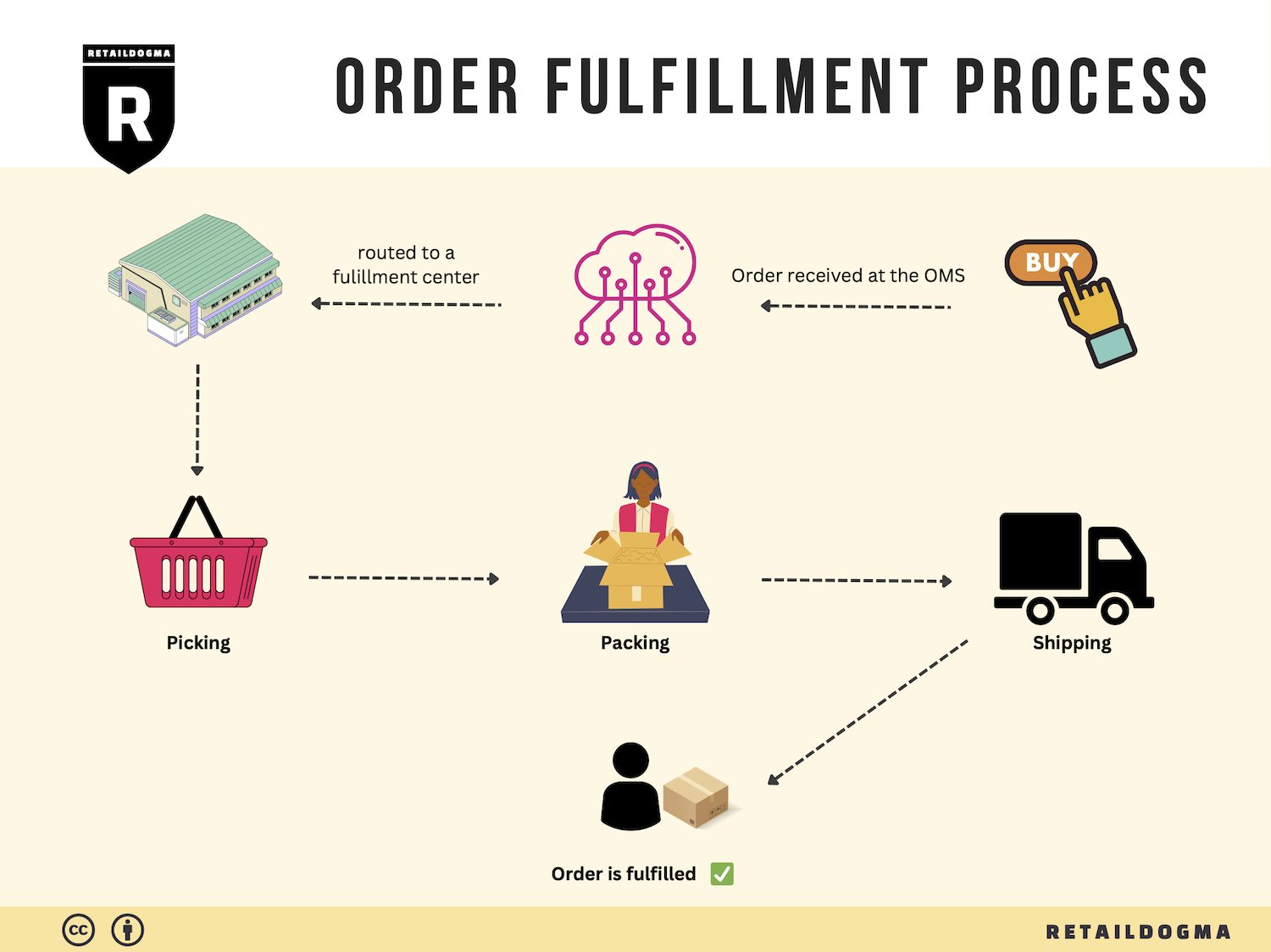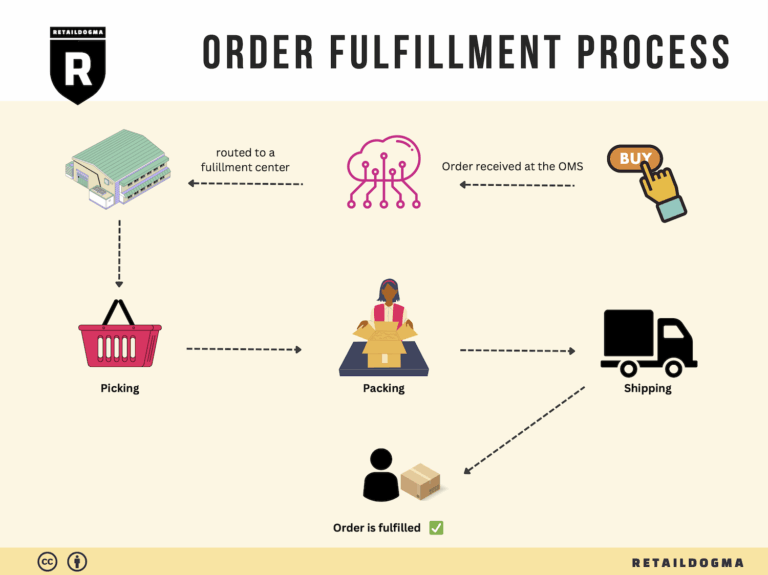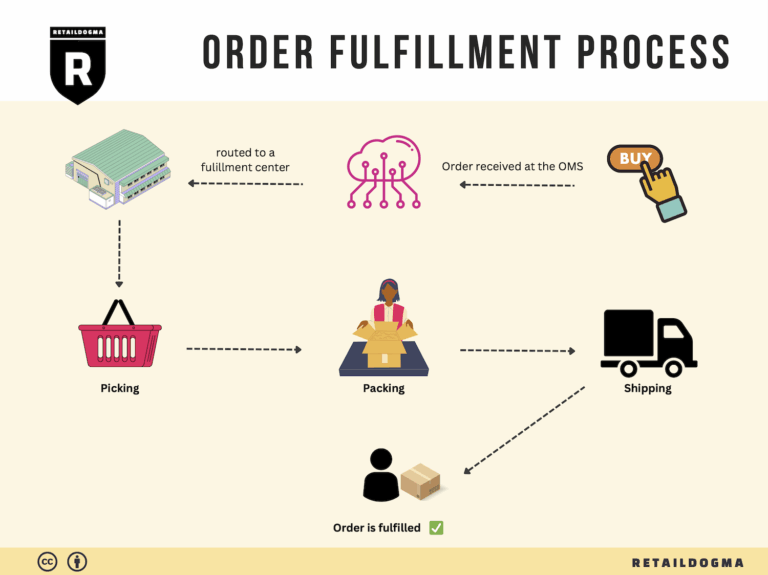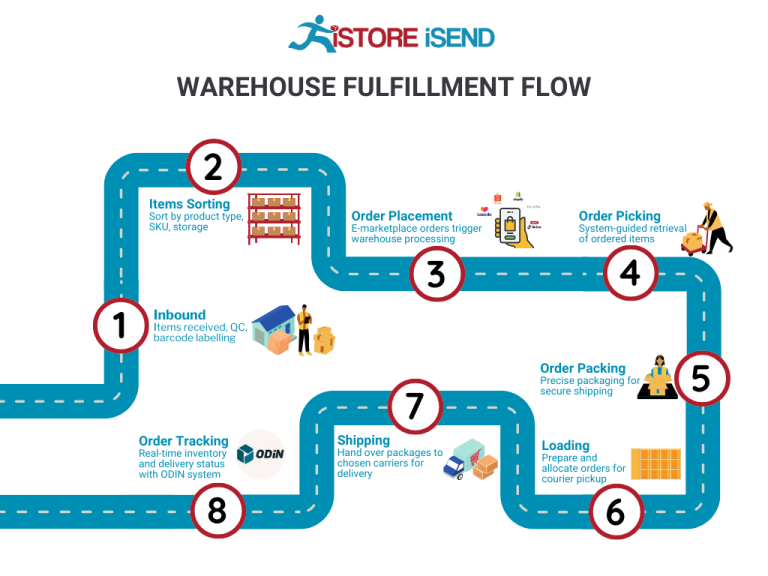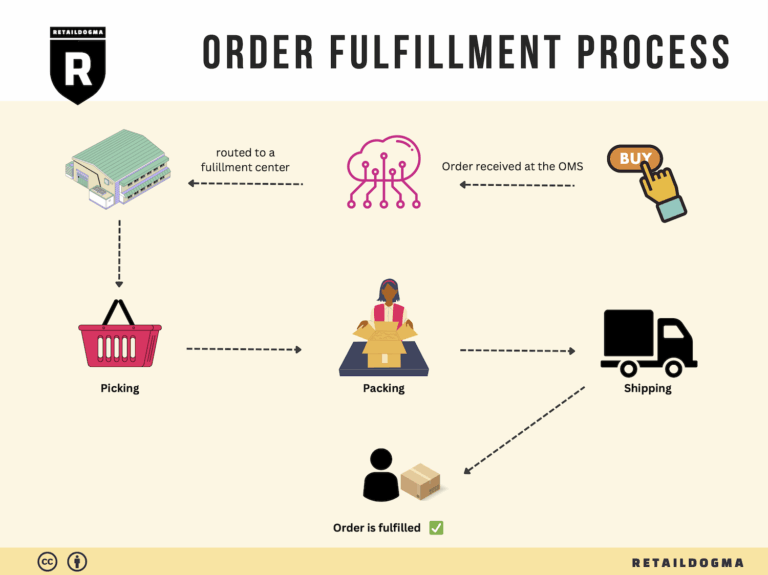How Order Fulfillment Works: A Step-by-Step Guide for Businesses
What is E-commerce Fulfillment? An Introduction for Growing Businesses
Understanding the Challenge of Order Fulfillment
As e-commerce businesses grow, many owners find themselves grappling with a common pain point: the overwhelming task of packing and shipping orders. What once seemed manageable can quickly spiral into a logistical nightmare as sales increase, leading to delayed shipments, inventory mismanagement, and ultimately, unhappy customers. This is where effective e-commerce fulfillment comes into play.
Fulfillment, in its simplest form, is the process of getting a product from your warehouse to the customer’s doorstep. It encompasses everything from inventory management and order processing to shipping and handling returns. As your business scales, mastering this process becomes crucial to maintaining customer satisfaction and ensuring operational efficiency.
What This Guide Will Cover
In this guide, we will explore the various models of fulfillment available to e-commerce businesses, including Third-Party Logistics (3PL) and Fulfillment by Amazon (FBA). Understanding these options will help you determine which model aligns best with your business goals.
We will delve into the core services offered by fulfillment providers, such as:
- Pick and Pack: The process of selecting items from your inventory, packaging them, and preparing them for shipment.
- Warehousing: Storage solutions that ensure your products are secure and easily accessible.
- Shipping Solutions: How to navigate shipping costs and delivery timelines effectively.
- Return Management: Streamlining the process of handling returns to minimize disruption.
Choosing the right fulfillment partner is a critical decision for any growing business. This guide will provide insights into what to look for in a partner, including their technology capabilities, customer service, and scalability options.
We will also discuss pricing structures commonly used in the fulfillment industry, helping you to understand the costs involved and how to budget effectively.
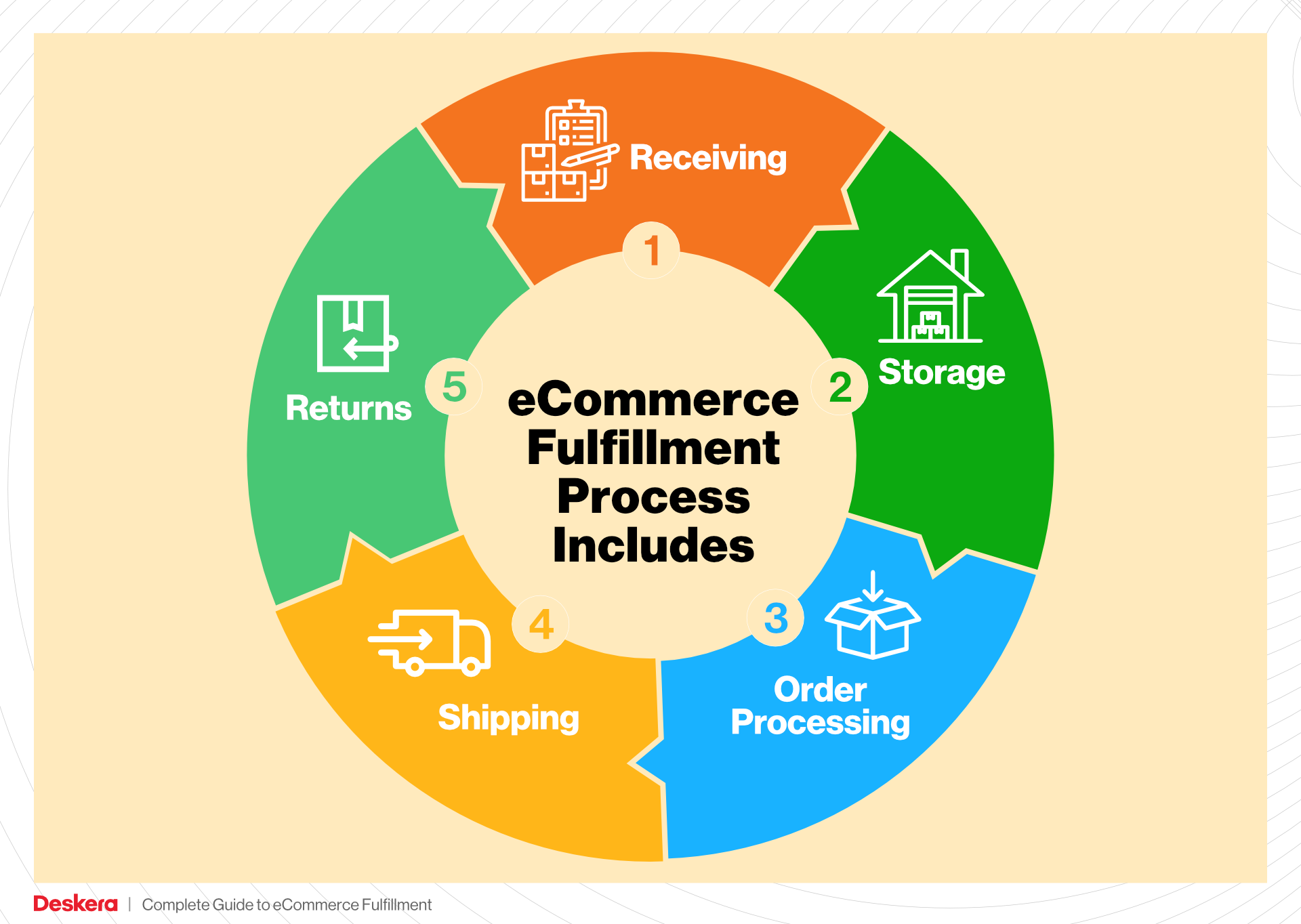
Empowering Smart Decisions
The ultimate goal of this guide is to empower you—e-commerce business owners, operations managers, and entrepreneurs—to make informed decisions about your logistics. By providing a clear understanding of e-commerce fulfillment, its models, and its services, we aim to equip you with the knowledge needed to scale your operations confidently and efficiently. Whether you are just starting out or looking to refine your existing processes, this guide will serve as a valuable resource on your journey to success.
What You’ll Learn In This Guide
- What is E-commerce Fulfillment? An Introduction for Growing Businesses
- The Order Fulfillment Process: From ‘Buy’ Button to Customer’s Door
- Comparing Fulfillment Models: In-House vs. 3PL vs. Dropshipping
- A Deep Dive into Amazon FBA: Pros, Cons, and Who It’s For
- Core Services Offered by Fulfillment Centers
- How to Choose a Fulfillment Partner: A 6-Point Checklist
- Understanding Fulfillment Pricing: A Breakdown of Common Fees
- Frequently Asked Questions (FAQs) about Fulfillment
- Conclusion: Is Outsourcing Fulfillment the Right Move for Your Business?
- Important Disclaimer
The Order Fulfillment Process: From ‘Buy’ Button to Customer’s Door
1. Receiving Inventory
The first step in the order fulfillment process is receiving inventory. When products arrive at the fulfillment center, they are checked against purchase orders to ensure accuracy. This involves verifying quantities, inspecting for damage, and confirming that the right items have been delivered.
Importance: Accurate receiving is crucial as it sets the foundation for inventory management. Any discrepancies at this stage can lead to stockouts, overstocks, or fulfillment delays.
Key Term: SKU (Stock Keeping Unit) – This unique identifier is assigned to each product to track inventory efficiently. Properly managing SKUs during receiving helps in maintaining accurate inventory counts and facilitates easier order processing down the line.
2. Warehouse Storage
Once the inventory is received and verified, the next step is warehouse storage. Products are organized and stored in designated areas within the fulfillment center. This organization can be based on various factors, including product type, size, and demand frequency.
Importance: Effective warehouse storage optimizes space utilization and improves the speed of order fulfillment. A well-organized warehouse minimizes the time spent locating products, directly impacting the efficiency of the picking process.
Key Term: Bin Locations – These are specific spots within the warehouse where products are stored. By assigning bin locations, fulfillment centers can streamline the picking process, making it easier for warehouse staff to find and retrieve items.
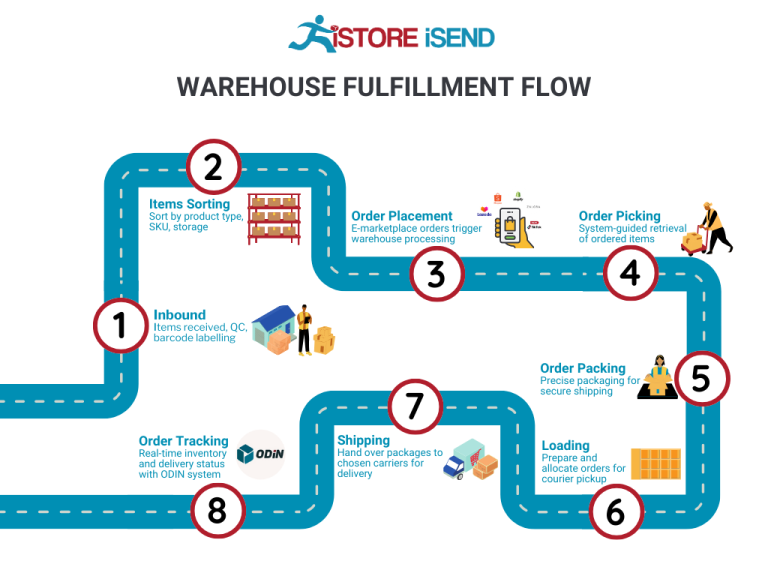
3. Order Picking
Order picking is the process of selecting the right items from the warehouse to fulfill customer orders. When an order is placed, a pick list is generated, detailing the items required for that order, their SKUs, and their bin locations.
Importance: This step is vital as it directly affects order accuracy and fulfillment speed. Efficient picking processes ensure that customers receive the correct products in a timely manner, fostering customer satisfaction and repeat business.
Key Term: Pick Lists – These documents guide warehouse staff in selecting items for orders. A well-structured pick list can significantly reduce picking time and errors, enhancing the overall efficiency of the fulfillment process.
4. Order Packing
After items are picked, they move to the packing station. Here, products are carefully packed into boxes or envelopes, often incorporating branding elements like custom boxes or stickers to enhance the customer experience. Packing also involves including necessary documentation, such as packing slips or return instructions.
Importance: Proper packing not only protects items during transit but also creates a positive unboxing experience for the customer. Attention to detail in this step can differentiate your brand and lead to increased customer loyalty.
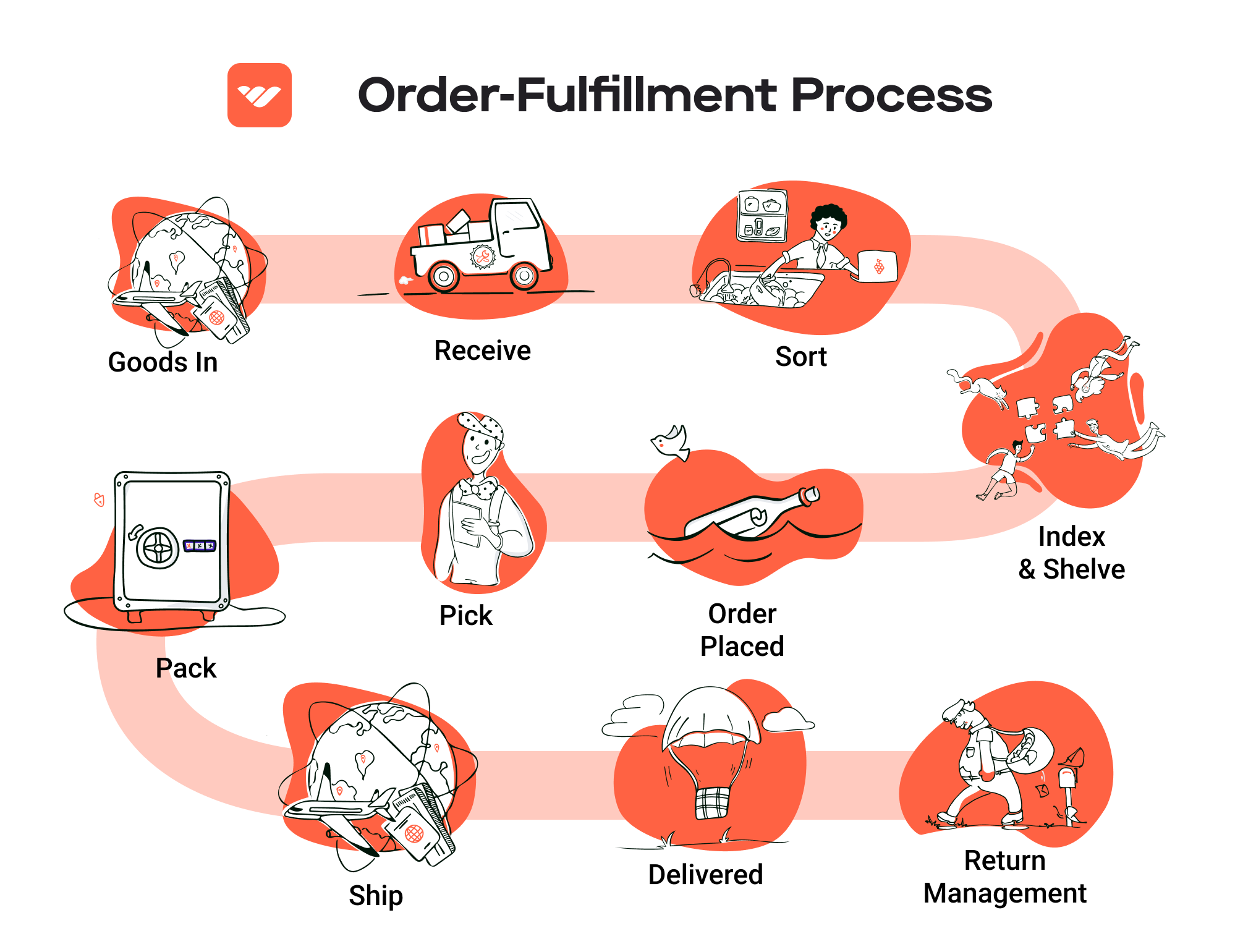
Key Term: Kitting – This refers to the process of assembling multiple items into a single package for shipment. Kitting can be an effective strategy for fulfilling complex orders that include multiple products, ensuring they are shipped together efficiently.
5. Shipping & Delivery
The final step in the order fulfillment process is shipping and delivery. Once orders are packed, they are labeled and handed over to shipping carriers. Fulfillment centers often have partnerships with various carriers to provide options for shipping speed and cost.
Importance: Timely shipping is critical to customer satisfaction. The faster and more reliably you can deliver products, the more likely customers are to return and recommend your business. This step also involves tracking shipments to keep customers informed about their order status.
Key Term: Shipping Network – This term refers to the established relationships and logistics systems that facilitate the movement of goods from fulfillment centers to customers. A robust shipping network can enhance your ability to deliver products efficiently, even internationally.
In summary, understanding and optimizing each step of the order fulfillment process—from receiving inventory to shipping and delivery—can significantly impact your e-commerce business’s success. By focusing on efficiency, accuracy, and customer experience, you can scale your operations and meet growing demand effectively.
Comparing Fulfillment Models: In-House vs. 3PL vs. Dropshipping
Fulfillment Model Comparison
| Model | Who Handles Inventory | Best For (Business Stage) | Key Advantage | Key Disadvantage |
|---|---|---|---|---|
| In-House Fulfillment | Business Owner/Staff | Established Businesses | Full control over operations and branding | High overhead costs and resource demands |
| Third-Party Logistics (3PL) | Third-Party Provider | Startups to Growth Stage | Scalability and expertise in logistics | Less control over inventory and processes |
| Dropshipping | Supplier | New Businesses | Low upfront investment and risk | Lower profit margins and reliance on suppliers |
In-House Fulfillment
In-house fulfillment involves managing the entire order fulfillment process internally, from inventory management to packing and shipping. Businesses that choose this model typically have established operations and sufficient resources to handle logistics without outsourcing. The primary advantage of in-house fulfillment is the complete control it affords over the entire process, allowing businesses to maintain their brand identity through customized packaging and customer service. This model also enables immediate response to inventory levels and customer demands, facilitating a personalized customer experience.
However, in-house fulfillment comes with significant drawbacks, particularly high overhead costs associated with staffing, warehousing, and technology. Businesses must invest in inventory management systems, shipping solutions, and physical storage space, which can strain finances, especially for smaller operations. Additionally, as order volumes grow, the demands on resources can lead to inefficiencies and potential fulfillment delays, ultimately affecting customer satisfaction.
Third-Party Logistics (3PL)
Third-party logistics (3PL) providers offer comprehensive logistics services, including warehousing, inventory management, packing, and shipping. This model is particularly beneficial for startups and businesses in the growth stage that may lack the infrastructure or expertise to manage fulfillment in-house. A key advantage of partnering with a 3PL is scalability; as order volumes fluctuate, businesses can easily adjust their logistics needs without the burden of excess overhead. Many 3PL providers, like eFulfillment Service, boast extensive shipping networks and integrations with various e-commerce platforms, allowing for seamless operations and reduced shipping costs.
Despite the advantages, utilizing a 3PL can result in a loss of control over inventory and fulfillment processes. Businesses must rely on the provider’s capabilities and responsiveness, which can vary significantly. Communication issues can arise, particularly if there are discrepancies in order fulfillment or inventory levels. Additionally, while 3PLs typically offer competitive pricing, businesses should be aware of potential hidden fees or contractual obligations that could impact profitability.
Dropshipping
Dropshipping is a fulfillment model where businesses sell products without holding any inventory. Instead, when a customer places an order, the retailer purchases the item from a third-party supplier, who then ships it directly to the customer. This model is ideal for new businesses or entrepreneurs who want to minimize upfront costs and risks associated with inventory management. The primary advantage of dropshipping is the low barrier to entry; businesses can launch an e-commerce store without investing heavily in inventory, storage, or fulfillment operations.
However, dropshipping also presents challenges. The most significant drawback is the lower profit margins, as businesses must price products competitively while also covering supplier costs. Additionally, reliance on suppliers for inventory and fulfillment can lead to inconsistencies in product availability and shipping times, which may negatively impact customer satisfaction. Businesses must also navigate potential quality control issues, as they have limited visibility over the products they sell. Overall, while dropshipping offers a flexible entry point into e-commerce, it requires careful supplier management and marketing strategies to ensure long-term success.
Conclusion
Choosing the right fulfillment model is crucial for scaling an e-commerce business. Each model—In-House Fulfillment, Third-Party Logistics (3PL), and Dropshipping—has distinct advantages and disadvantages that can significantly impact operational efficiency and customer satisfaction. In-house fulfillment offers control but comes with high costs, while 3PL provides scalability and expertise at the expense of some control. Dropshipping minimizes risk and investment but can lead to lower margins and quality challenges. Understanding these dynamics will help business owners make informed decisions that align with their growth strategies and operational capabilities.
A Deep Dive into Amazon FBA: Pros, Cons, and Who It’s For
Understanding Fulfillment by Amazon (FBA)
Fulfillment by Amazon (FBA) is a service provided by Amazon that allows sellers to store their products in Amazon’s fulfillment centers. Amazon takes care of storage, packaging, shipping, and customer service, allowing sellers to focus on other aspects of their business. This service has gained significant traction among e-commerce businesses, particularly those looking to leverage Amazon’s vast customer base and logistics capabilities.
When a customer orders a product listed with FBA, Amazon handles the entire process. This includes picking the product from the warehouse, packing it, and shipping it directly to the customer. Additionally, Amazon manages returns and customer inquiries, providing a seamless experience for both sellers and buyers.
How FBA Works
-
Account Setup: Sellers start by creating an Amazon seller account and enrolling in the FBA program. This process involves agreeing to Amazon’s terms and conditions and setting up payment methods.
-
Product Listing: Sellers can list their products on Amazon and choose to fulfill them through FBA. They need to provide details about the items, including pricing, images, and descriptions.
-
Shipping Inventory to Amazon: Sellers prepare their products according to Amazon’s guidelines and ship them to designated fulfillment centers. Amazon provides shipping labels and guidelines to ensure products are sent correctly.
-
Storage and Fulfillment: Once the inventory arrives at Amazon’s warehouse, it is stored until an order is placed. When a customer purchases a product, Amazon handles the entire fulfillment process, including packing and shipping.
-
Customer Service: Amazon takes care of customer service for FBA orders, which includes handling returns, refunds, and inquiries. This service is particularly beneficial for sellers who may not have the resources to manage customer service independently.
-
Payment: After a sale, Amazon deducts its fees from the sale price and transfers the remaining amount to the seller’s account.
Pros of FBA
-
Prime Eligibility: Products fulfilled through FBA are eligible for Amazon Prime, which significantly enhances visibility and sales potential. Prime members often prefer purchasing items that can be shipped quickly and free of charge.
-
Increased Customer Trust: Leveraging Amazon’s reputation can instill confidence in potential buyers. Customers often feel more secure purchasing from sellers who use FBA, knowing that Amazon handles fulfillment and customer service.
-
Multi-Channel Fulfillment: FBA allows sellers to fulfill orders from other platforms, such as their websites or eBay, using Amazon’s logistics. This flexibility can help sellers manage inventory and streamline operations.
-
Scalability: FBA can accommodate growing businesses by allowing sellers to scale their operations without needing to invest heavily in warehousing or logistics. Amazon’s infrastructure can handle increased order volumes efficiently.
-
Time Savings: By outsourcing fulfillment to Amazon, sellers can focus on marketing, product development, and customer engagement rather than logistics.
Cons of FBA
-
High Fees: While FBA can save time and effort, the associated fees can be significant. Sellers incur storage fees for inventory held in Amazon’s warehouses and fulfillment fees per item sold. These costs can eat into profit margins, especially for low-cost products.
-
Strict Inventory Rules: Amazon has specific guidelines regarding inventory management. Sellers must comply with these rules to avoid penalties, including long-term storage fees for items that do not sell quickly.
-
Commingling Risks: FBA uses a commingled inventory system, meaning that products from different sellers can be stored together. This can lead to issues if a seller’s products are damaged or if there are quality concerns, as it can be challenging to trace back to the original seller.
-
Limited Control: Once products are in Amazon’s fulfillment centers, sellers have limited control over the fulfillment process. Issues with packaging, shipping times, or customer service fall under Amazon’s purview, which may not always align with a seller’s brand standards.
-
Dependency on Amazon: Relying on FBA can create a dependency on Amazon’s platform, which may pose risks if policies change or if competition increases. Sellers should consider diversifying their sales channels to mitigate this risk.
Who is FBA Best For?
Fulfillment by Amazon is an excellent option for various types of sellers, particularly:
-
Small to Medium-Sized Businesses: Businesses that lack the resources to handle logistics, storage, and customer service may find FBA beneficial. It allows them to leverage Amazon’s infrastructure without needing to invest heavily in their logistics.
-
New Sellers: Entrepreneurs looking to enter the e-commerce space can benefit from the ease of use and brand credibility associated with FBA. It allows them to test products and markets with less risk.
-
High-Volume Sellers: Businesses that anticipate high sales volumes can take advantage of Amazon’s scalability and efficient logistics network, saving time and resources.
-
Sellers Focused on Growth: For sellers looking to expand their reach quickly, FBA provides access to Amazon’s vast customer base and the ability to offer Prime shipping, which can enhance sales.
In summary, FBA presents a powerful solution for e-commerce businesses aiming to streamline their logistics and enhance customer trust. However, sellers must carefully weigh the pros and cons and assess their unique business needs before fully committing to this fulfillment method.
Core Services Offered by Fulfillment Centers
Inventory Management & Warehousing
Inventory management and warehousing are foundational components of e-commerce fulfillment services. Fulfillment centers provide businesses with secure, organized storage for their products, allowing them to manage stock levels efficiently. This involves not only storing inventory but also tracking it in real-time, which is crucial for maintaining optimal stock levels and avoiding stockouts or overstock situations.
Benefits:
1. Real-Time Tracking: Advanced inventory management systems allow e-commerce businesses to monitor stock levels in real time, providing visibility into what products are available and when to reorder. This ensures that businesses can meet customer demand without delays.
-
Cost Efficiency: By outsourcing warehousing, businesses can save on the costs associated with maintaining their own storage facilities. Fulfillment centers often offer scalable storage solutions, meaning businesses only pay for the space they use.
-
Reduced Risk of Loss: Fulfillment centers typically implement stringent security measures, reducing the risk of inventory loss due to theft or damage. This assurance allows businesses to focus on growth rather than worrying about inventory safety.
-
Integration with E-commerce Platforms: Many fulfillment centers offer seamless integration with e-commerce platforms, enabling automatic updates of inventory levels as sales occur. This integration streamlines operations and enhances overall efficiency.
Pick and Pack Services
Pick and pack services refer to the process of selecting items from inventory (picking) and preparing them for shipment (packing). Fulfillment centers utilize systematic approaches to ensure that products are accurately picked and packaged according to customer orders. This service is essential for maintaining high order accuracy and fast turnaround times.
Benefits:
1. Efficiency and Speed: Fulfillment centers employ trained staff and optimized workflows to ensure that orders are processed quickly. This efficiency leads to faster shipping times, which is critical in today’s competitive e-commerce landscape.
-
Accuracy in Order Fulfillment: High accuracy rates in picking and packing help prevent costly errors that can lead to customer dissatisfaction and returns. Many fulfillment centers boast accuracy rates above 99%, which is essential for maintaining a positive customer experience.
-
Custom Packaging Options: Fulfillment centers often provide customizable packaging solutions that allow businesses to enhance their brand image. Branded packaging can create memorable unboxing experiences, which can lead to repeat business and customer loyalty.
-
Scalability: As businesses grow, their order volumes can fluctuate. Fulfillment centers can easily scale their pick and pack operations to match demand, ensuring that businesses can handle peak seasons without compromising service quality.
Kitting and Assembly
Kitting and assembly services involve grouping multiple products together into a single package or assembling products before they are shipped. This service is particularly beneficial for businesses that offer bundled products or require assembly prior to delivery.
Benefits:
1. Streamlined Operations: By outsourcing kitting and assembly, businesses can reduce the complexity of their logistics operations. Fulfillment centers handle the labor-intensive aspects of assembling products, allowing businesses to focus on core activities like marketing and sales.
-
Enhanced Customer Offerings: Kitting allows businesses to create unique product bundles that can attract customers. For example, a subscription box service can benefit from kitting to deliver curated experiences tailored to customer preferences.
-
Cost Savings: Managing kitting in-house can require significant labor and time. By outsourcing this function, businesses can save on labor costs and reduce the time spent on order preparation.
-
Flexibility: Fulfillment centers can adapt quickly to changes in demand for specific kits or assembled products. This flexibility is especially important for seasonal promotions or new product launches.
Returns Management (Reverse Logistics)
Returns management, or reverse logistics, is the process of handling returned products efficiently. Fulfillment centers streamline this process, allowing e-commerce businesses to manage returns with minimal disruption to their operations.
Benefits:
1. Improved Customer Satisfaction: A smooth returns process enhances the customer experience. Fulfillment centers ensure that returns are processed quickly, refunds are issued promptly, and customers receive clear communication throughout the process.
-
Inventory Control: Efficient returns management helps businesses maintain accurate inventory levels. Fulfillment centers inspect returned items, restock them when appropriate, and provide real-time updates to inventory systems.
-
Cost Reduction: Handling returns can be costly, particularly if done inefficiently. Fulfillment centers leverage their expertise to minimize costs associated with processing returns, including transportation and labor costs.
-
Data Insights: Many fulfillment centers provide analytical tools that help businesses understand return trends and reasons for returns. This data can be invaluable for improving product offerings and reducing future returns.
In conclusion, partnering with a fulfillment center can provide e-commerce businesses with essential services that enhance operational efficiency, improve customer satisfaction, and ultimately drive growth. By leveraging the core services of inventory management, pick and pack, kitting, and returns management, businesses can scale their operations with confidence.
How to Choose a Fulfillment Partner: A 6-Point Checklist
Location & Warehouse Network
Importance:
The geographical location of your fulfillment partner’s warehouses can significantly impact shipping times and costs. A partner with strategically placed warehouses can facilitate faster delivery to your customer base, which is crucial for maintaining satisfaction and loyalty.
Questions to Ask:
– Where are your warehouses located, and how many do you operate?
– What is your average shipping time to my primary customer regions?
– How do you handle international shipping and customs clearance?
Technology & Integrations
Importance:
In today’s e-commerce landscape, seamless technology integration is essential for efficient operations. A robust fulfillment partner should offer real-time tracking, inventory management, and easy integrations with your existing e-commerce platform.
Questions to Ask:
– What inventory management system do you use, and how does it integrate with my shopping cart?
– Can you provide real-time order tracking for my customers?
– How do you handle data security and compliance with regulations?
Specializations (e.g., Cold Storage, Oversized Items)
Importance:
Different businesses have varying needs based on the nature of their products. If your business sells perishable goods, oversized items, or specialized products, it’s crucial to partner with a fulfillment service that has the necessary capabilities and experience.
Questions to Ask:
– Do you have experience handling my specific product type? (e.g., food items, heavy machinery)
– What specialized storage options do you offer, such as climate control or temperature-sensitive storage?
– How do you manage inventory for products with specific handling requirements?
Scalability & Capacity
Importance:
As your business grows, so will your fulfillment needs. Selecting a partner that can scale their services with you ensures that you won’t have to switch providers as you expand, which can be a costly and disruptive process.
Questions to Ask:
– How do you accommodate fluctuations in order volume, such as seasonal spikes?
– What is your maximum order capacity, and how quickly can you ramp up operations if needed?
– Can you provide case studies or examples of how you’ve supported other clients during periods of growth?
Pricing and Contracts
Importance:
Understanding the pricing structure and contract terms of a fulfillment partner is critical for budgeting and financial planning. Look for transparency in costs and flexibility in contract terms to avoid hidden fees or long-term commitments that may not suit your business.
Questions to Ask:
– What are your pricing models, and what services are included?
– Are there any hidden fees, such as setup fees or storage fees?
– What are the terms of your contracts, and do you offer flexibility if my business needs change?
Customer Support & Reviews
Importance:
Reliable customer support is vital for resolving issues quickly and maintaining smooth operations. Additionally, reviews and testimonials can provide insights into the partner’s reliability, service quality, and overall reputation in the industry.
Questions to Ask:
– What kind of customer support do you offer, and what are your response times?
– Can you provide references or case studies from clients in my industry?
– How do you handle complaints and issues that arise during the fulfillment process?
Conclusion
Choosing the right fulfillment partner is a pivotal decision for any e-commerce business looking to scale operations effectively. By using this checklist, you can systematically evaluate potential partners based on their location, technology, specializations, scalability, pricing, and customer support. Each point serves as a foundation for informed decision-making, ensuring that your chosen partner aligns with your business goals and enhances your operational efficiency.
Understanding Fulfillment Pricing: A Breakdown of Common Fees
Initial Setup Fees
Initial setup fees are one-time charges that cover the costs associated with onboarding your business with a third-party logistics (3PL) provider. These fees can include the integration of your e-commerce platform with the fulfillment center’s system, initial inventory setup, and sometimes even training your staff to navigate the new processes.
The calculation of these fees varies widely among providers. Some may charge a flat fee, while others might base it on the complexity of your inventory or the number of SKUs (Stock Keeping Units) you plan to store. It’s essential to clarify with your 3PL whether they have any setup fees and what exactly they cover, as many providers now offer options with no setup fees to attract new clients.
Receiving Fees
Receiving fees are charged for the process of accepting and processing your inventory when it arrives at the fulfillment center. This fee typically covers the labor required to unload, inspect, and inventory your products.
The calculation for receiving fees can be based on various factors, including the volume of inventory being received and the specific requirements for handling it. For instance, a 3PL might charge per pallet or per item, with additional costs for special handling, such as fragile or oversized items. Understanding these fees upfront helps in budgeting your overall fulfillment costs effectively.
Storage Fees (per pallet/bin)
Storage fees are ongoing charges for keeping your inventory in the fulfillment center’s warehouse. These fees are usually calculated on a per-pallet or per-bin basis and can vary based on the size and type of products you store.
Typically, storage fees are charged monthly, and the rates can differ based on the duration of storage. Many 3PL providers offer tiered pricing where the cost per pallet decreases as your inventory volume increases. It’s important to inquire about any long-term storage fees, as some providers may impose additional charges if your products remain unsold for an extended period.
Pick & Pack Fees (per item/order)
Pick and pack fees are charged for the labor involved in retrieving items from storage and preparing them for shipment. This process generally includes picking the items, packing them securely, and labeling them for shipping.
The calculation of pick and pack fees can vary based on the fulfillment center’s pricing model. Some charge a flat fee per order, while others may charge per item included in the order. It’s crucial to understand how your 3PL defines these fees, especially if you anticipate a high volume of small orders, as this can significantly impact your overall fulfillment costs.
Shipping Fees
Shipping fees are the costs associated with sending your products to customers. These fees can vary significantly based on factors such as the shipping method (standard, expedited, international), package weight, dimensions, and destination.
Shipping fees are often calculated based on negotiated rates with carriers. Many 3PL providers have established relationships with major shipping companies, allowing them to offer competitive rates. It’s advisable to ask your 3PL about their shipping options and any potential discounts for high-volume shipping, as these can lead to substantial savings over time.
Tips for Getting an Accurate Quote
When seeking a quote from a 3PL provider, it’s crucial to provide comprehensive information about your business needs. Here are some tips to ensure you receive an accurate quote:
-
Detailed Inventory List: Provide a complete list of the SKUs you intend to store, including dimensions and weight. This helps the provider estimate storage and shipping fees accurately.
-
Volume Estimates: Share your projected order volumes, including seasonal fluctuations. This information can help the 3PL tailor their services and pricing to meet your needs.
-
Specific Requirements: Be clear about any special handling requirements, such as kitting, labeling, or temperature control, as these can influence pricing.
-
Inquire About Hidden Fees: Ask about any additional or hidden fees that might apply, such as long-term storage fees or costs for returns processing.
-
Comparison Shopping: Don’t hesitate to compare quotes from multiple providers. This can help you identify competitive pricing and services that best fit your business model.
By taking these steps, you can gain a clearer understanding of fulfillment pricing and make informed decisions that align with your e-commerce growth strategy.
Frequently Asked Questions (FAQs) about Fulfillment
1. What is a 3PL (Third-Party Logistics) provider?
A 3PL provider is a company that offers logistics services, including warehousing, fulfillment, shipping, and distribution, to businesses on an outsourced basis. By partnering with a 3PL, e-commerce businesses can leverage their expertise, technology, and resources to streamline operations and focus on growth.
2. What is the difference between a warehouse and a fulfillment center?
While both a warehouse and a fulfillment center store goods, their functions differ. A warehouse primarily focuses on inventory storage and may not be equipped for order processing. In contrast, a fulfillment center is designed specifically for order fulfillment, including picking, packing, and shipping orders directly to customers.
3. How do fulfillment services work?
Fulfillment services involve a series of steps: receiving inventory from suppliers, storing products in a fulfillment center, picking and packing orders as they come in, shipping them to customers, and managing returns. Many fulfillment providers also offer inventory management systems that integrate with e-commerce platforms for real-time tracking and updates.
4. How much do fulfillment services cost?
The cost of fulfillment services varies based on several factors, including the volume of orders, the size and weight of products, storage needs, and specific services required (like kitting or returns management). Most 3PLs offer transparent pricing with no hidden fees, making it essential to request quotes to understand the total cost based on your unique business needs.
5. What types of businesses can benefit from 3PL fulfillment services?
3PL fulfillment services are beneficial for various businesses, especially e-commerce retailers, startups, and companies experiencing rapid growth. They allow businesses to scale operations without the burden of managing logistics, making them ideal for those looking to focus on core activities like marketing and product development.
6. How can I choose the right 3PL provider for my business?
When selecting a 3PL provider, consider factors such as their industry experience, range of services, technology integration capabilities, customer service quality, and pricing structure. It’s also advisable to read reviews and case studies to gauge their reliability and effectiveness in meeting client needs.
7. What is order accuracy, and why is it important?
Order accuracy refers to the percentage of orders that are fulfilled correctly, without errors. High order accuracy is crucial for maintaining customer satisfaction and loyalty. A reliable 3PL provider should have a high order accuracy rate, which indicates their efficiency in managing fulfillment processes.
8. How can I manage inventory effectively with a 3PL?
Most 3PL providers offer inventory management systems that integrate with your e-commerce platform. This allows you to monitor stock levels in real-time, forecast inventory needs, and receive alerts for low stock. Effective communication with your 3PL is also vital for timely inventory replenishment.
9. What are the advantages of using a 3PL for international shipping?
Using a 3PL for international shipping offers several advantages, including expertise in navigating complex customs regulations, access to a robust shipping network, and cost-effective solutions for global distribution. A good 3PL can streamline the international shipping process, ensuring timely delivery while minimizing potential issues.
10. How do I handle returns with a 3PL provider?
Most 3PLs offer returns management services, which handle the entire process from receiving returned items to inspecting and restocking them. By leveraging these services, businesses can simplify their returns process, maintain accurate inventory records, and provide a better customer experience. Always confirm the return policies and processes with your chosen 3PL to ensure they align with your business needs.
Conclusion: Is Outsourcing Fulfillment the Right Move for Your Business?
Evaluating the Benefits of Outsourcing Fulfillment
Outsourcing your fulfillment process can be a transformative decision for your e-commerce business. By leveraging a third-party logistics (3PL) provider, you can significantly save time and resources, allowing you to focus on what truly matters—growing your business. Fulfillment services streamline operations by handling inventory management, order processing, and shipping logistics, which can reduce your operational burden and lead to increased efficiency.
One of the standout benefits of utilizing a fulfillment partner is scalability. As your business grows, so do the complexities of managing orders and inventory. A reliable 3PL service can seamlessly adapt to your changing needs, providing you with the flexibility to scale operations without the headaches associated with managing logistics in-house. This adaptability is crucial in today’s fast-paced e-commerce environment, where consumer demands can shift rapidly.
Moreover, partnering with a fulfillment expert brings invaluable industry knowledge and resources. Experienced providers understand the nuances of shipping, international regulations, and best practices for inventory management. Their expertise can help you navigate challenges and optimize your logistics strategy, ensuring that your customers receive their orders promptly and accurately.
However, not all fulfillment partners are created equal. Choosing the right 3PL provider is critical for your growth trajectory. Look for a partner that aligns with your business values, offers transparent pricing, and provides exceptional customer service.
To determine if outsourcing fulfillment is the right move for your business, conduct a thorough audit of your current shipping and logistics processes. Evaluate your pain points and consider the potential for improved efficiency and customer satisfaction through a dedicated fulfillment partner. Taking this strategic step could unlock new avenues for growth and success in your e-commerce journey.
Important Disclaimer
⚠️ Important Disclaimer
The information in this guide is for educational purposes. Fulfillment services, pricing, and platform features change frequently. Always conduct your own due diligence and consult with providers directly before making business decisions.
